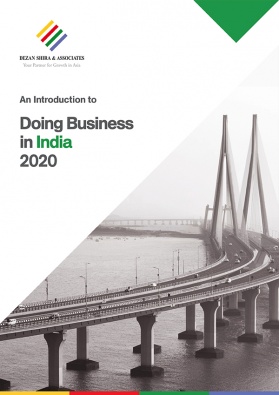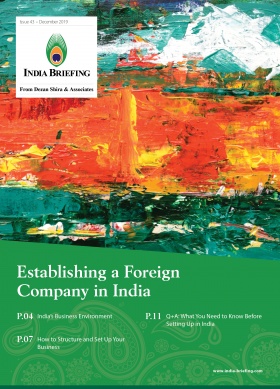Developing Prospects for Growing Trade Between India and Brazil
In about ten years, India will be as important to Brazil as China is today. This is because the South Asian country is a major consumer of agricultural products and Brazil is one of the main producers in the world. Added to this is the fact that per capita income in India has increased and the country has a huge population. The trend is for both regions to further strengthen their economic ties.
The per capita income of Indians grew 4.2 percent in 2019 and there are signs that the growth – notwithstanding COVID-19 in 2020 – will continue to rise. All main trends indicate an ongoing increase for the next decade and during this time India will become increasingly important as a commercial partner to Brazil. At the beginning of the year, the Brazilian government committed to doubling bilateral trade by 2022. Studies indicate that this demand could be sustained for more than 30 years.
India, in addition to having a huge area, is also very large in terms of population, and has significant economic growth potential, just like its neighbor, China. India is also a young country whereas China is aging. The consequence of this is that India will demonstrate increasingly higher purchasing power; food consumption too will increase as the country progresses and the spending power of its middle class increases.
The phenomenon of what is happening in India today is the same that happened in China in the early 1990s. China, initially a marginal business partner, became the main destination for Brazilian exports. According to the Indian potential, something similar should happen – India could very well become one of the main consumers of Brazilian agricultural commodities, such as soy, sugar, and coffee, among others.
India still does not import soy from Brazil. India’s major Brazilian imports are oil, non-monetary gold, fats, vegetable oils, sugars, cotton, and raw wood. As the population’s purchasing power improves, changes in consumption patterns will be inevitable and India could become an important buyer of soy from Brazil, just as it happened with China.
Due to religious beliefs, Indians do not consume large amounts of meat. The low consumption of this product in the market has led to the population compensating for these protein needs by eating chickpeas, peas, and lentils etc. Brazil can present itself as a major exporter of these products. It is worth noting that India is the world’s largest producer of pulses, with a production of 19 million tons (Mt), but consumes 21 Mt, with a propensity to increase, indicating the need to import pulses as well.
As the middle class expands in size, there will automatically be a need for the country to manufacture more or increase the import of more consumables – this presents a positive point for Brazil, the fourth largest food producer in the world.
India’s path towards sustainable and prolonged development will lead to the growth of demands similar to the Chinese experience; it is why the country is becoming a priority trade partner of Brazil. This began to show itself in 2017, when, for the first time, the percentage of Indian GDP growth exceeded that of China.
India’s economy is the seventh largest in the world in GDP and is expected to be the third largest by 2030, reaching second place by 2050, representing 15 percent of world GDP.
India and Mercosur
Mercosur is the free trade area that includes Argentina, Brazil, Paraguay, and Uruguay. It is also the only trade agreement that India currently has with a fellow member of the BRICS grouping (the bloc contains Brazil, Russia, India, China, South Africa).
While the preferential trade agreement (PTA) between India and Mercosur is presently limited to just 450 products, the two sides have raised their ambitions and are currently negotiating preferential access to about 3,000 items.
India wants to export processed foods, more engineering goods, and a wider range of pharmaceuticals to the Mercosur. Under these circumstances, the India-Mercosur PTA can be considered a success.
In terms of actual products, under the existing agreement signed in 2009, India has brought down duties in the range of 10 percent to 100 percent on 452 items. These include meat products, chemicals, raw hides and skins, leather articles, wool, cotton yarn, glass and glassware, iron and steel, machinery and equipment, optical, photographic, and cinematographic apparatus.
India has preferential access in the Mercosur for organic chemicals, pharmaceuticals, essential oils, plastics and articles, rubber and rubber products, tools and implements, machinery items, and electrical machinery and equipment. A full text of the India-Mercosur PTA can be found here.
The advantage of Mercosur for India, and especially its wealthy, vested interest business connections, is that the Mercosur bloc is some distance away and is unlikely to pose much of a threat to domestic businesses in the Indian domestic market. Brazilian exporters should be looking to take advantage of this and examine the suitability of the Indian market for Brazilian exports.
In summary, Brazilian export manufacturers have excellent opportunities to increase their production, as they have numerous options suitable to meet India’s consumer requirements.
Related Reading
-
- Developing Free Trade Between India and Mercosur
 Importing and Exporting in India In this special edition of India Briefing magazine, we examine India’s import and export landscape, basic import and export procedures, and customs duties.
Importing and Exporting in India In this special edition of India Briefing magazine, we examine India’s import and export landscape, basic import and export procedures, and customs duties.
About Us
India Briefing is published by Asia Briefing, a subsidiary of Dezan Shira & Associates. We produce material for foreign investors throughout Eurasia, including ASEAN, China, Indonesia, Russia, the Silk Road, & Vietnam. For editorial matters please contact us here and for a complimentary subscription to our products, please click here.
Dezan Shira & Associates provide business intelligence, due diligence, legal, tax and advisory services throughout India and the Asian region. We maintain offices in Delhi and Mumbai and throughout China, South-East Asia, India, and Russia. For assistance with India investment issues or into Asia overall, please contact us at india@dezshira.com or visit us at www.dezshira.com.
- Previous Article India Bans TikTok and 58 Other Chinese Apps from Their Domestic Market. Is it a Big Deal?
- Next Article Desarrollando Perspectivas para el Crecimiento del Comercio entre India y Brasil









